Arctica Travel Guide
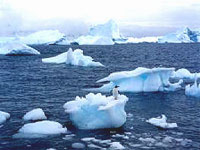
Penguin on iceberg in Antarctica © Judith Duk
Antarctica can lay claim to several prizes in the continent stakes: it is the coldest, windiest and driest continent on earth, and with an average altitude of 7,382ft (2,250m), it is also the highest. The extreme frigidity and ferocious winds, as well as its isolation at the bottom of the world, combine to make Antarctica one of the most inhospitable places on the planet, neither inhabited by a native population nor presided over by an indigenous government.
Yet growing numbers of people are compelled to travel to this vast continent, double the size of Australia; a land of pristine whiteness, where its creatures have figured out remarkable ways to survive a life in the freezer. The landscape is as harsh as it is magical. Icebergs of indescribable beauty are carved and polished into fantastic shapes and sizes by the elements, patterns of blue ice form irregular etchings on the face of floating ice chunks, and the roar of calving glaciers echoes between sheer-sided channel walls. Roughly scoured peaks of rock and ice are reflected in the serene waters of protected bays that are frequented by basking seals and inquisitive whales. The coastal shores and sub-Antarctic islands are home to hundreds of squawking and honking penguin rookeries and seal colonies as well as nesting seabirds; the incessant commotion and comic antics of half a million tuxedoed forms is one of the most characteristic and endearing features of a trip to the Antarctic Peninsula.
The Peninsula is the northernmost finger that points to South America, and together with the islands of the Sub-Antarctic, is the most visited region and the best place to view wildlife in Antarctica. Most visits are on organised ship-based expeditions that aim to showcase the scenic highlights of the region as well as to educate visitors about the wildlife, historical sites and active research bases.
Antarctica is not an easy place to get to, nor is it a cheap holiday destination; part and parcel of this quest for adventure will more than likely involve a rough sea crossing, as well as an itinerary at the mercy of changing weather and ice conditions. However, those that choose to journey to the 'end of the world' can be sure of experiencing a voyage incomparable to any other.
Overview Argentina
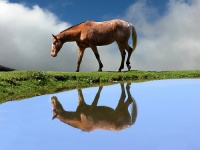
A pony's reflection in the water in Argentina © fainmen
Argentina is a country of immense beauty and proportions. Its geographic diversity spans the most breathtaking terrain from Antarctica, through the wild, glacier-filled mountains of Patagonia and massive open plains of La Pampas to the deserts and tropical jungles in the north.
The country can be enjoyed for its natural wonders alone, but no visit here could be called complete without stepping into its soul, its capital city. The elegant Buenos Aires is home to 40 percent of the population, and is a buzzing metropolis with a rich, passionate and tortured history that is integral to its character. It is Europe and South America contained in one geographical location, with elements of the unknown around each corner. It is familiar and strange at the same time, but at its very core, wonderfully welcoming.
Along the elegant avenues of the fashionable districts, sophisticated diners observe passers-by while they sip strong coffee or enjoy smooth cervezas. There is a constant smell of meat grilling from every corner and sidewalk that reveals the Argentine passion for 'asado'. Neither glamour nor passion is in short supply in this cosmopolitan hub where Porteños are equally versed in football, politics and fashion.
There are disparities between the rich and poor, with many people living in near slum conditions in the outskirts of Buenos Aires. Since 1992 the economy has teetered near collapse due to corruption and government mismanagement, prompting regular and sometimes violent demonstrations. However it is business-as-usual as far as tourism is concerned; in fact, the resultant devaluation of the peso has made the country much more affordable for travellers.
Belize
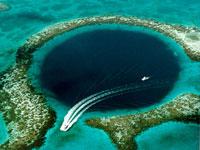
Blue Hole
About the same size as Wales, Belize rests on the Caribbean coast between Mexico and Guatemala: an exotic, English-speaking, adventurer's paradise, just a couple of hours away from three major United States cities. Almost half the country has been preserved as nature parks and reserves, including tropical forests teeming with wildlife and hiding mysterious Mayan ruins, and 174 miles (280km) of coastline featuring the longest barrier reef in the Western Hemisphere.
The reef and the country's numerous offshore cayes, or atolls, have made this one of the world's most desirable destinations for scuba divers and marine researchers. They come to explore unique features like the famous 'Blue Hole', a collapsed submerged cave 1,000 feet (305m) in diameter and 412 feet (126m) deep.
Archaeologically Belize is fascinating too, having been the site of mighty Mayan cities from around 1,000 BC until the inexplicable disintegration of that great civilisation around 900 AD. There are believed to be thousands of Mayan ruins in Belize, of which about 600 have been discovered and excavated, many now open to tourists.
Like most Caribbean countries Belize was occupied by British and Spanish colonialists over the centuries before gaining independence (only lately recognised by neighbouring Guatemala which laid claim to the territory) in 1981. Today it is a happy-go-lucky multi-ethnic nation of warm, friendly people, very welcoming of the tourists on whom the country's economy relies heavily.
The main urban city (although not the capital) is Belize City, which offers some attractions like a world-class zoo, a new museum, historic buildings and the Maya site of Altun Ha. Basically, though, Belize is a destination for the outdoor enthusiast and adventure traveller. There are not many nightclubs, expensive shopping venues or fancy restaurants, but there is plenty of scope for diving, snorkelling, fishing, hiking, birdwatching, kayaking and exploring.
Bolivia
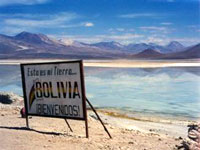
Salar de Uyuni © Judith Duk
Bolivia is known as the 'Tibet of the Americas', the highest and most remote of the countries in South America. It is a landlocked region with two Andean mountain ranges binding the Altiplano, or High Plain, between them. This plain has an altitude ranging from 9,000ft to 13,000ft (3,000m to 4,000m) and is where the majority of the population live.
The history of the region dates back to the pre-Columbian times, from the ancient Aymará civilisation in 1,500 BC who lived on Lake Titicaca, to the Tiahuanaco and the Inca Empire of the Altiplano, until the conquest of the Spanish in 1538. Reminders of these civilisations are evident in the architecture of the colonial cities, displayed in informative museums that can be visited at the sites of ancient ruins.
Bolivia is one of South America's more intriguing countries, as one with the most indigenous population on the continent, the majority of whom still maintain their firmly established culture and beliefs. This living historical culture is one of the reasons that Bolivia is such an exciting tourist destination. Travellers will encounter shy people in traditional clothing, colourfully dressed and red-cheeked from the mountain air. The landscape is imbued with traditional houses and age-old methods of agriculture, and visitors will find remarkable traditions kept alive in the ancient techniques of weaving, handcraft and food production. The sounds of this cultural legacy echo in the haunting melodies of the panpipes from the high Altiplano or in the lively tunes emanating from the warmer lowlands.
The dramatic geography affords many adventure opportunities: explorers can track wildlife in the Amazonian basin, drive across the surreal landscape of the Salar de Uyuni, take a boat trip on the world's highest navigable lake, Titicaca, scramble through muddy shafts in the silver mines of Potosi, or hike in the magnificent Andes mountains. There is enough diversity to meet many tastes.
The country is a juxtaposition of extraordinary altitudes and spectacular landscapes, fascinating remains of ancient civilisations, a rich indigenous culture and vast colonial treasures.
Brazil

Palms on a Brazilian beach © F H Mira
The long-lasting impression most visitors leave Brazil with is of carefree, colourful people dancing and celebrating in the street parades at Carnaval, and of a passion for life and exuberance of spirit that charms visitors from around the world. Tourists descending on the country's fabulous cities, such as hedonistic Rio de Janeiro, can enjoy the five-star hotels, shopping malls, beautiful beaches, sunny skies and inspirational restaurants without really having to confront the hundreds of shantytowns (favelas) where the poorest of the poor eke out a living in the shadows of the skyscrapers.
With booming mining, agricultural and manufacturing sectors, Brazil has the highest GDP in Latin America and is expected to be one of the world's dominant economies by the middle of this century. Brazil also caters well for business tourism and is a favoured destination for conventions, congresses and expos, particularly the city of Sao Paulo, which is the country's largest city and the business capital of Brazil.
Being so vast, larger than continental United States, Brazil offers a variety of cultures and topographies. The range is evident in the contrast of the Amazon rain forest to the mountain towns of Minas Gerais, the urban jungle of Sao Paulo and the vast central plateau around Brasilia and the world-famous beaches of Copacabana and Ipanema. It all adds up to an exotic and exciting Latin American mix where the common denominators are samba, sunshine, sultry smiles and soccer.
Chile Travel Guide

Autumn in Chile © mabahamo
A Chilean legend maintains that after God had created the wonders of the world he had many pieces leftover. He had raging rivers, sprawling glaciers, valleys and soaring mountains, snow-capped volcanoes, sparkling lakes, beautiful forests and deserts, icy fjords and sandy beaches. Rather than let all this beauty go to waste, he put them together in a remote part of the world, and so Chile was born.
Shaped like a long narrow strip and making up the western part of South America's tail, it is 2,610 miles (4,200km) in length and at most 115 miles (180km) wide. Travellers are drawn to this country because of its multitude of natural attractions, from the northern desert to the Lake District, and the mountains and fjords of Patagonia in the south. It has some superb National Parks, including Easter Island famous for its mysterious giant statues, and numerous activities for outdoor enthusiasts.
Chile's European heritage is evident throughout the country and travellers here are likely to feel more familiar with its culture than those of the neighbouring countries, with their strongly indigenous lifestyles. There are still local traditions persisting in parts of Chile however, and together with the European influence this makes for an interesting juxtaposition, providing a distinctive culture. The people are resilient, cordial and warm, from the fashionable capital city of Santiago to the isolated island of Chiloé, and Chilean hospitality is renowned.
Besides natural beauty and an interesting blend of cultures, Chile offers the visitor excellent wines and seafood, unique handicrafts and shopping, and a variety of characteristic architecture, making it a beautiful and memorable place to visit.
El Salvador Travel Guide
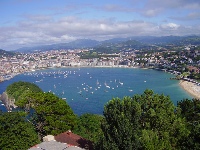
San Sebastian © innocacionweb
Plenty of breathtaking sightseeing opportunities await the traveller coming into this most lush of Central American nations. Lush because it's one of the most volcanic places on Earth, producing fertile soil and a thriving wilderness in its small 8,124 square miles (21,040km²).
Interspersed between the forest, mountains and 21 volcanoes are the best preserved remains of the Mayan civilisation. Joya de Cerén is all that remains of a Mayan site buried under volcanic ash 1,400 years ago and a UNESCO World Heritage Site. The San Andrés region and the ruins of Tazumal boast well-preserved structures as hallmarks to this ancient civilisation.
Getting around the small country is easily achieved by bus or taxi. The longest journey is between San Salvador to La Palma and lasts a meagre four hours, making internal flights redundant. San Salvador and San Sebastian are the main attractions. The latter is a popular picturesque beachside resort village, a town of quaint Romanesque sights and simple beauty. San Salvador, by contrast, is the hub of a rapidly industrialising country, it is densely populated and crime-ridden. Still, visitors can enjoy a wide range of sights in the city; colonial cathedrals and buildings including the Catedral Metropolitana, St Ignatius Loyola and the Spanish façade. Atop San Jacinto Mountain one can enjoy a panoramic vista of the city as well as an amusement park and cable car rides.
Honduras Travel Guide
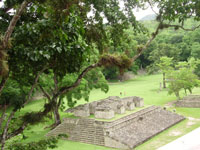
Copan Ruins
Exuding an air of paradise with its exotic palm-fringed beaches, clear turquoise waters, majestic mountains, verdant jungles and beguiling Mayan ruins, the laid back way of life and relative obscurity to the tourist market makes Honduras an ideal holiday getaway for those who enjoy getting off the beaten track.
It has all the right ingredients for a tourist hotspot; pristine beaches, great hotels and a rich cultural history. Despite this, Honduras has scarcely registered on the Western radar in the past, other than its 15 minutes of fame in 1998 when it was ravaged by Hurricane Mitch. These days it is enjoying a boom in popularity as a relatively unknown, unspoilt and undeveloped destination, recognised for its Ecotourism opportunities, affordable scuba diving, mountain treks and river rafting, as well as its appeal to the rich and famous eager to escape the prying eye of the paparazzi.
Toucans pose alongside orchids in the humid cloud forests and mountains, while banana plantations cover the rest of the aptly named 'Banana Republic', famous for its banana cake, banana pancakes, fried plantain and banana chips. Many ancient Mayan and Lenca ruins can be found hidden away from civilisation in lush jungle landscapes, ready to enchant the most seasoned of travellers. One of the country's most breathtaking Mayan archaeological sites is the Copan Ruins, a World Heritage Site set in a verdant valley in the far western region of Honduras, reminiscent of something out of an Indiana Jones movie.
The once thriving port of Trujillo has an intriguing pirate history and exquisite tropical beaches, while the region known as the Mosquito Coast, which extends towards the Nicaraguan border, is the largest tract of tropical rainforest north of the Amazon and is one of the most popular spots in the world for ecotourism. The country also boasts 373 miles (600km) of Caribbean white sand beaches, and the offshore Bay Islands such as Utila, Roatan and Guanaja are an extremely popular destination, particularly for divers and snorkellers. There is plenty more to discover in this exciting country, however, and the warmth and hospitality of the Honduran locals is bound to lure first time visitors back time and time again.
Panama Travel Guide
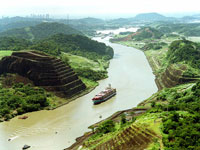
Panama Canal © Panama Canal Authority
Covering a land-bridge which links North and South America, the Republic of Panama is best known for its 40-mile long (65km) shipping canal, which is cut along a gap between mountains, linking the Caribbean Sea to the Pacific Ocean. The country is largely unexplored by tourists; only a few hardy adventurers, researchers and spirited travellers have had the joy of discovering its amazing diversity of flora and fauna, secluded beaches, tropical beauty and historic treasures. The name, Panama, means 'abundance of fish and butterflies', in an indigenous language, which gives a good indication of the wild wonders to be found here, beyond its rather daunting, but fascinating capital, Panama City.
Panama has a significant history stretching back thousands of years, from its eight indigenous peoples (including the colourful Kunas of the San Blas Islands) to its turbulent colonial occupation. Spanish forts stand along the coastline, overlooking the blue waters once patrolled by famous pirates like Henry Morgan, and where Sir Francis Drake was buried at sea.
It is the natural beauty of the isthmus that offers so much for visitors, however. Around 30 percent of Panama is made up of 15 national parks and forest reserves, and 10 wildlife sanctuaries, like the incredible Parque Nacional Darién, just a short drive from Panama City, which is the most magnificent wilderness area in Central America. Archipelagos of about 1,500 offshore islands, their white soft beaches lapped by crystal clear waters, sport virgin rainforest and are an untouched paradise for divers, snorkellers, deep-sea fishing, water sports and sunbathers.
Those 'in the know' can be forgiven for keeping the delights of Panama a secret from the flood of modern tourism, because this has preserved the integrity of this overlooked part of the world where the sun always shines and it is possible to swim in two oceans in a single morning.
Venezuela
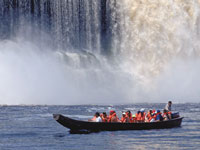
Angel Falls © angel-ecotours.com
Venezuela means 'Little Venice' in Spanish, the name given to this northerly country in South America by the early explorers when they found the natives living on the Sinamaica lagoon, in houses built on stilts, close to the present day oil rich city of Maracaibo. Lately there has been considerable political tension in the country with an attempted coup in April 2003; political demonstrations remain frequent and can often become violent. Despite this Venezuela is full of friendly, smiling people, which is hardly surprising because the country has an abundance of natural resources, including one of the biggest oil reserves in the world.
Nature has also blessed this country with diverse landscapes, from miles of beautiful Caribbean beaches to open plains, towering mountains, tracts of Amazon rain forest and even a small desert. In the southeast in Bolivar State the Gran Sabana National Park contains the spectacular Angel Falls, the world's highest waterfall.
Venezuela's cities are similarly scenic, particularly the capital, Caracas, which sprawls in a long, thin valley flanked by the majestic Avila Mountain. Caracas is lively, green and clean, with a rich cultural life, vibrant nightlife, great restaurants and marvellous modern shopping malls. A favourite excursion in Caracas is to ride the cable car to the summit of the Avila. The popular city of Merida, in the Andes, also has its cable car, and this one takes tourists on a one-hour journey to the highest point in Venezuela, the Pico Bolivar, which reaches more than 16,404ft (5,000m).
Venezuela has a little bit of everything that Latin America has to offer, with the addition of thousands of miles of Caribbean coastline, and the constantly pleasant temperature that makes it good year-round destination.






















 Halong Bay is located in the Northeast of Vietnam, belonging to QuangNinh Province. It is in the coastal area stretching from 1060 56’ to 1070 37’ east longitude and 200 43’ to 210 09’ north latitude. To the west and northwest, Halong Bay stretches from Yen Hung District, and includes the large urban areas of Halong City and Cam Pha Town, as well as Van Don Island District. To the south and southeast, it is adjacent to the western Tonkin Gulf and to the west and southwest lies Cat Ba Island in the province of Hai Phong. On the world map, Ha Long Bay borders to China in the north and in the east it is adjacent to the East Sea.
Halong Bay is located in the Northeast of Vietnam, belonging to QuangNinh Province. It is in the coastal area stretching from 1060 56’ to 1070 37’ east longitude and 200 43’ to 210 09’ north latitude. To the west and northwest, Halong Bay stretches from Yen Hung District, and includes the large urban areas of Halong City and Cam Pha Town, as well as Van Don Island District. To the south and southeast, it is adjacent to the western Tonkin Gulf and to the west and southwest lies Cat Ba Island in the province of Hai Phong. On the world map, Ha Long Bay borders to China in the north and in the east it is adjacent to the East Sea. 








